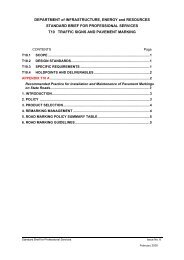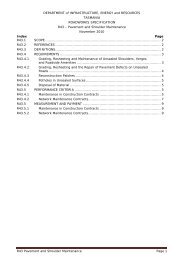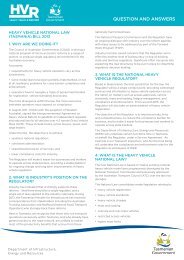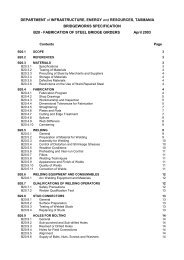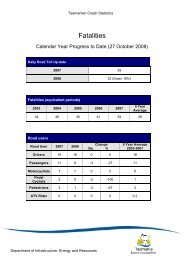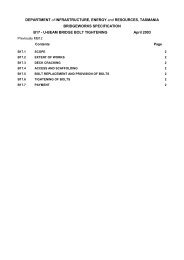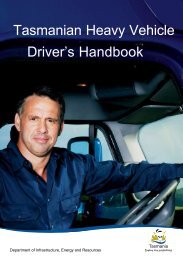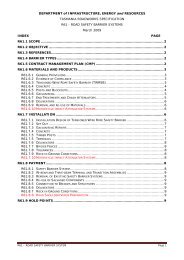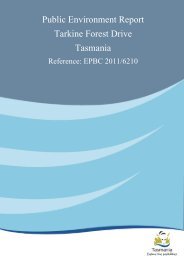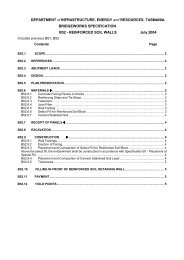Operator Accreditation Manual - Transport
Operator Accreditation Manual - Transport
Operator Accreditation Manual - Transport
You also want an ePaper? Increase the reach of your titles
YUMPU automatically turns print PDFs into web optimized ePapers that Google loves.
There are a number of regular inspections that apply to<br />
vehicles used to provide passenger transport services.<br />
Some of these are required by law and others form<br />
part of the <strong>Accreditation</strong> Standards. These must all be<br />
included in your vehicle management system under<br />
Module 2.<br />
The schedules are outlined below:<br />
Activity Timing Carried out by Reference<br />
Pre-departure<br />
inspection<br />
Before the first departure<br />
of the day<br />
Driver, employee, operator<br />
or person nominated by<br />
the Responsible Person<br />
Standard 2.2<br />
Roadworthiness<br />
inspection<br />
6 or 12 monthly,<br />
depending on the vehicle<br />
Approved Inspection<br />
Station<br />
Standard 2.1<br />
Safety inspection Every 6 months or 10,000<br />
km, whichever comes first<br />
Qualified mechanic<br />
or person approved<br />
by registered training<br />
organisation<br />
Standard 2.4<br />
Documents to keep<br />
You must keep a record of all of the relevant<br />
documentation that supports your vehicle<br />
management system. This forms part of the record<br />
keeping requirements set out in Standard 1.2. The<br />
records and documents you must keep are:<br />
• Reports and documents relating to each<br />
vehicle you operate:<br />
o Vehicle register (Standard 1.4)<br />
o Registration documents (Standard 1.4)<br />
o All roadworthiness inspection reports for<br />
each vehicle (Standard 2.1)<br />
o All completed pre-departure inspection<br />
checklists for each vehicle (Standard 2.2/<br />
Form 2.2);<br />
o All fault reports for each vehicle<br />
(Standard 2.3/Form 2.3);<br />
o Records of repairs undertaken as a result<br />
of faults identified, including the date the<br />
work was carried out and the name of the<br />
person or organisation undertaking the<br />
work (Standard 2.3/Form 2.3);<br />
o Records of major vehicle safety<br />
inspections including the date of the<br />
inspection, the inspection findings and<br />
the name of the person who undertook<br />
the inspection (Standard 2.4)<br />
• Your service’s emergency management<br />
procedures (Standard 2.5/Form 2.5)<br />
You may also wish to retain vehicle records that<br />
are not required to be kept for the purpose of<br />
accreditation, such as:<br />
• Records of replacements and modifications to<br />
the vehicle (including the date the work was<br />
carried out and the name of the person or<br />
organisation undertaking the work)<br />
• Records of scheduled maintenance and<br />
services for each vehicle<br />
It may assist you when developing your vehicle<br />
management system to make a list of all tasks<br />
involved in keeping your vehicle records up to date<br />
and the names (or position titles) of the people who<br />
are responsible for carrying out each task. You may<br />
also wish to consider the procedures you have in<br />
place for ensuring that all relevant staff can access<br />
your vehicle management documentation.<br />
You must retain all vehicle records for at least<br />
three (3) years. (In effect, the documents that were<br />
examined during your previous compliance audit<br />
may be securely discarded following successful<br />
completion of the next ongoing compliance audit.)<br />
10 Passenger <strong>Transport</strong> Sevices <strong>Operator</strong> <strong>Accreditation</strong> <strong>Manual</strong>



